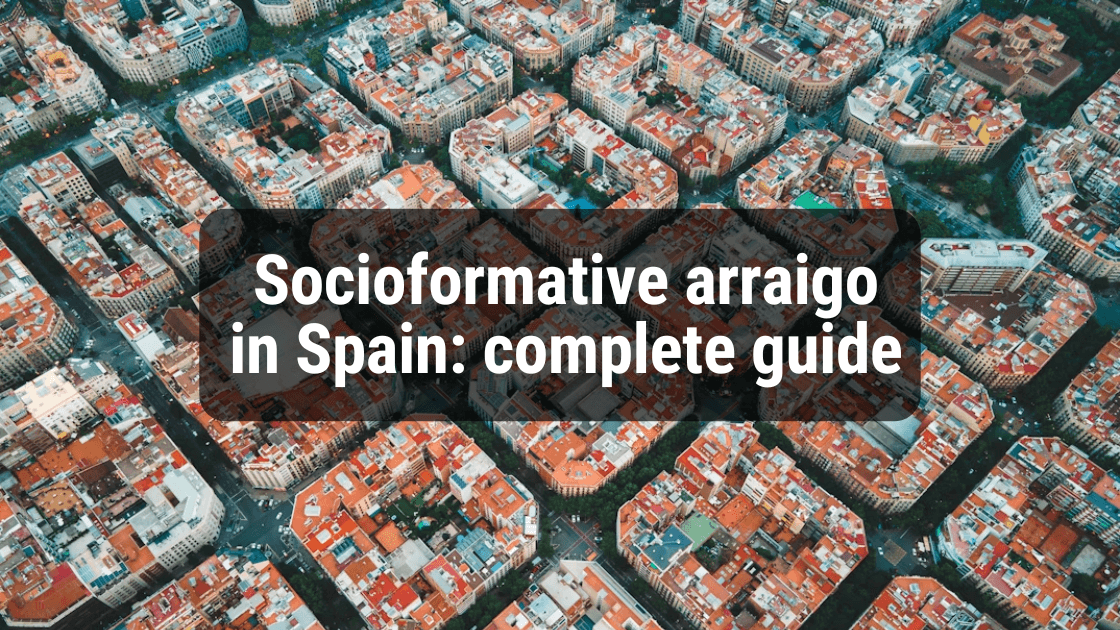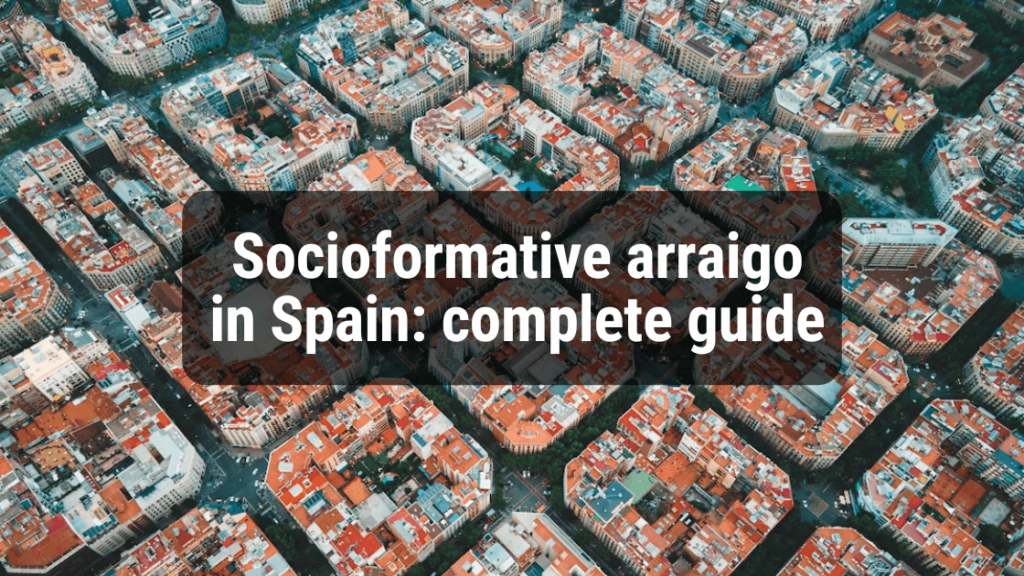
Have you been living in Spain illegally for some time and are looking for a way to legalize your status in 2025? Socio-educational arraigo or arraigo socioformative has become one of the most talked-about options following the latest reform of the Immigration Regulations.
Not only does it allow you to obtain legal residence for one year, but it also allows you to train in a sector with a future and then make the leap to a stable work permit.
In this article, we explain, step by step, exactly what socioformative (arraigo socioformativo) is, what the key requirements are, how to apply for it, and what benefits it offers compared to other authorizations. If you want to learn about this new concept that is marking a turning point in immigration in Spain, keep reading.
Let’s get started!
Content
ToggleWhat is socioformative arraigo?
Socioformative arraigo is a residence permit granted in exceptional circumstances to foreigners who have been in Spain illegally for at least two years and who are starting a specific training program.
In other words, this residence permit is designed to enable you to study in Spain, train, and improve your professional profile.
This option was created with the reform of the Immigration Regulations (RD 629/2025, of May 20), and it is very favorable, among other things, because it not only allows you to regularize your status, but also to improve your professional profile so that you can stay in Spain long-term and work legally.
It is a one-year authorization, which, once completed, can be converted into a work permit.
In addition, the training you take can be in person or partly online (hybrid format), as long as a maximum of 50% is taught online.
Main differences with the old arraigo para la formación
The socio-educational residence permit came into effect on May 20, 2025, with the entry into force of the new reform of the immigration regulations.
From this date onwards, the former arraigo para la formación became the new arraigo socioformativo.
But its name is not the only thing that changes. Here are the main differences:
- Firstly, the minimum time required to qualify in Spain is reduced from 3 to 2 years.
- Secondly, it is now possible to work up to 30 hours per week (something that was not possible with the old arraigo for training).
The requirement for an arraigo report is introduced (something we will look at later).
Arraigo socioformativo requirements
Below are the main requirements for obtaining socioformative arraigo:
- Not an EU citizen.
- Provide a passport (valid and in force).
- Prove a minimum stay in Spain of 2 years prior to the application, during which you cannot have registered any departures exceeding 90 days in this 2-year period. This is proven by historical registration.
- Obtain a social integration report (integration report)
- Have no criminal record in Spain or in the countries where you have resided during the last 5 years
- Not be an applicant for international protection at the time of submitting the application, nor during its processing
- Be enrolled, currently studying, or submit an application for admission (commitment to start) to a course or training program.
- Full training in professional certificates (levels 1, 2, and 3) taught by authorized entities registered in the state registry, training promoted by the SOC or the
- Continuing Education Consortium, and post-compulsory secondary or adult education are permitted.
Can I work with socioformative arraigo?
Yes, with socio-educational roots, you can work up to 30 hours per week.
The most important thing to bear in mind in order to be able to work is that your job must pay you at least the minimum wage in Spain (SMI) corresponding to and proportional to the hours you work, or the minimum defined by the collective agreement.
Bear in mind that you cannot work full-time, and this job must allow you to combine your studies with your employment.
How to obtain arraigo socioformativo step by step
Below, we analyze the application process that you must follow in general to obtain arraigo socioformativo:
1. Enroll in a training program. The first thing you must do is enroll in an official or authorized course in Spain. It must be a formal training program, with a minimum number of hours and endorsed by the administration. You can find the rest of the details in this article.
2. Prepare all the documentation. Valid passport, registration with the local council, criminal record certificate, and course registration. Everything must be up to date and, if it comes from abroad, translated into Spanish and legalized.
3. Make an appointment at the Immigration Office. The application is submitted in person or online, depending on your province. Here, it is recommended that you have an immigration lawyer who can submit the documentation for you.
4. Submit the application form and pay the fee. Fill out the official form (EX-10) and pay the corresponding fee. Without this step, the process cannot begin.
5. Wait for the decision. The administration has up to three months to respond, although in practice, this time is likely to be longer. If the decision is favorable, you can apply for your residence card (TIE).
6. Collect your TIE from the National Police. Once you have received a positive decision, make an appointment at the police station. Take photos, fingerprints, and proof of the decision with you to obtain your card.
Main benefits for foreigners
There are many advantages to socioformative arraigo. Let’s look at the main ones:
- Firstly, you can work in any sector for up to 30 hours per week.
- Once you have completed your training and your residency card is about to expire, you can change to a work permit and stay in Spain long-term.
- You will also have the option of changing to a self-employed work permit to carry out your professional activity as a freelancer.
Frequently asked questions on the arraigo socioformativo
Below, we analyze some of the most frequently asked questions about this residence permit for exceptional circumstances.
Can I apply for this arraigo from outside Spain?
No, socioformative ararigo must be requested from Spain while in an irregular situation, as it is a residence permit that allows foreigners to regularize their situation and requires them to have remained in Spanish territory for two years immediately prior to the date of application.
What happens if I quite the training?
In the case of arraigo socioformativo, the granting of residency is conditional on your actually attending and completing the training for which you requested authorization.
This means that if you drop out of the course once you have obtained your card, you would be failing to comply with the essential requirement that justified its granting.
What would happen then?
This could mean that when the time comes to renew your residence permit, the authorities will not allow you to do so, because they will verify that you did not fulfill the purpose of the permit.
In extreme cases, they could even initiate proceedings to revoke your authorization, as the basis for your residence would no longer exist.
Can I change the course once started?
Yes, it is possible to change courses, but under very clear conditions and always notifying the authorities and ensuring that the course meets the legal requirements.
You can change courses if you meet the following requirements:
- The new course must also be authorized and approved for socio-educational integration.
- The change must be communicated to the Immigration Office, providing proof of the new enrollment.
- There cannot be an intermediate period without being enrolled, because the authorization is granted precisely to pursue that training.
Upon renewal, they will verify that you have indeed completed valid training, even if it is not the same as the initial training.
Do you have any further questions, or would you like to receive personalized advice from a team of experts? Each case is different. Our office can help you assess whether you meet the requirements, choose the best training, and submit your application without errors.
Get in touch with our lawyers and let us guide you step by step:
Pide cita con nuestros abogados a continuación y deja que nuestros expertos te guíen paso a paso:





